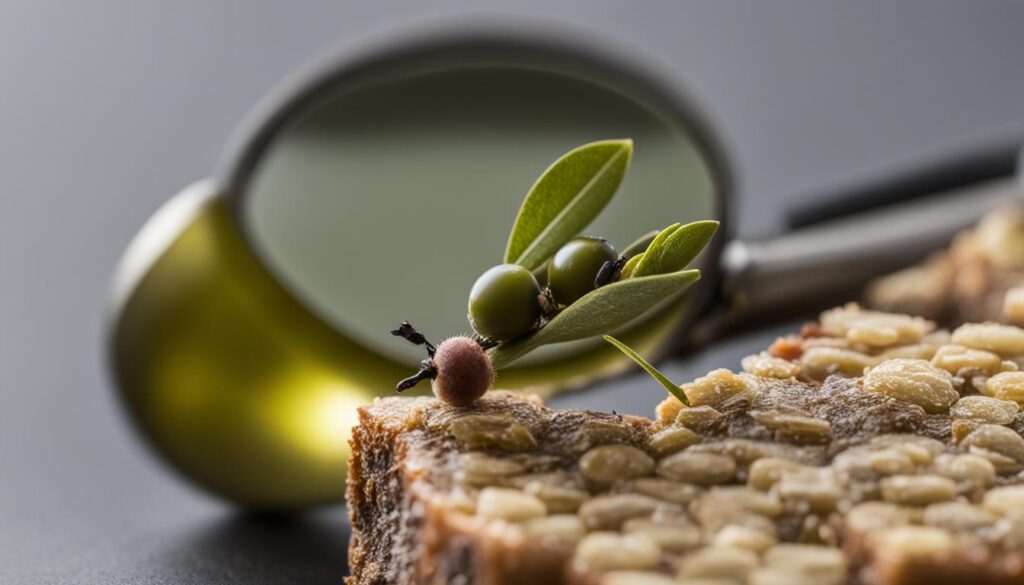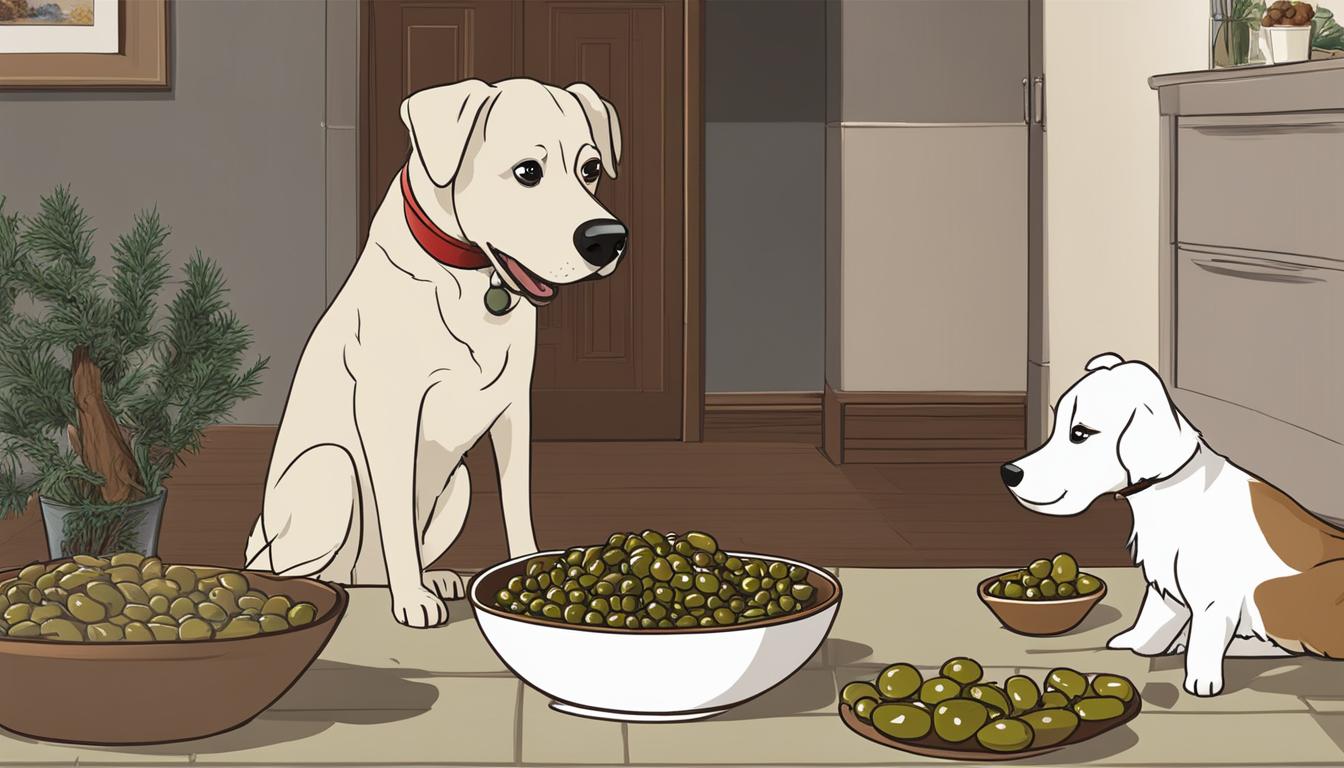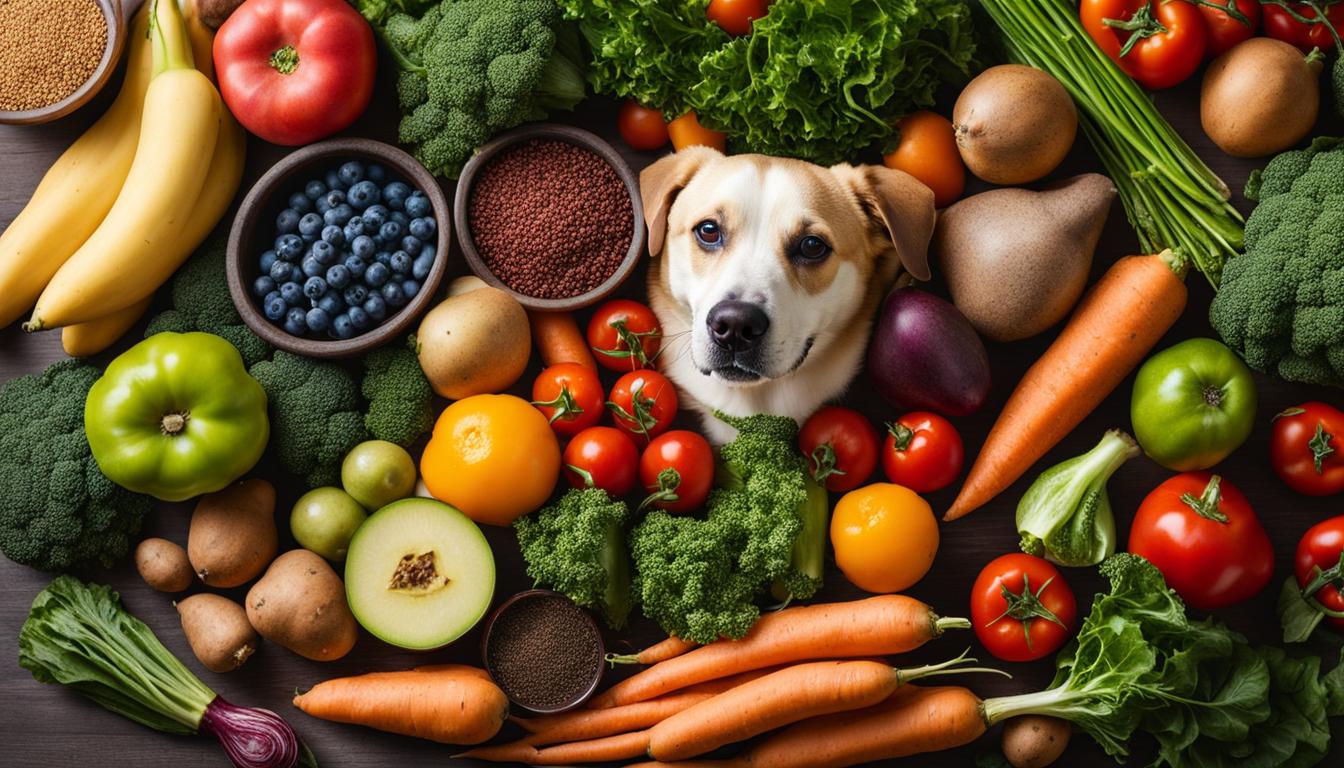Welcome to our guide on whether dogs can eat olives! If you’ve ever wondered if your furry friend can join you in enjoying this tasty snack, we’re here to provide all the information you need. With their diverse texture and savory flavor, olives may seem like a tempting treat for your canine companion. But before you reach for that olive jar, it’s important to understand the potential risks involved.
Key Takeaways:
- Olives are not toxic to dogs and can be safe in moderation.
- Pits in olives pose a choking hazard and can cause intestinal blockage if ingested.
- Excessive sodium in canned or pickled olives can be harmful to dogs.
- Seasonings, marinades, and oils on olives carry additional risks.
- Consult a veterinarian if your dog consumes a large amount of olives or shows any adverse reactions.
Nutritional Benefits of Olives for Dogs
When it comes to the nutritional benefits of olives for dogs, these small fruits pack quite a punch. Olives are rich in antioxidants, including vitamin E and polyphenols, which can help reduce inflammation and support a healthy immune system in dogs. These antioxidants play a crucial role in fighting free radicals and promoting overall health. Incorporating olives into your dog’s diet can provide them with a natural boost of these beneficial compounds.
In addition to antioxidants, olives are a great source of monounsaturated fats. These healthy fats promote a healthy skin and coat in dogs, keeping their fur shiny and reducing the risk of skin irritation. They also have the potential to lower the risk of heart disease by supporting cardiovascular health. However, it’s important to note that olives should still be given in moderation, as excessive fat intake can cause digestive issues in dogs.
Olives also offer a good amount of fiber, which plays a crucial role in a dog’s digestion. Adequate fiber intake helps prevent constipation and promotes regular bowel movements. It also aids in maintaining a healthy gut microbiome, which is essential for overall gastrointestinal health. The vitamins and minerals found in olives, such as vitamins A, E, K, and B complex, as well as iron, calcium, and magnesium, further contribute to a dog’s well-being.
Table: Nutritional Content of Olives
| Nutrient | Amount per 100g of Olives |
|---|---|
| Calories | 115 |
| Protein | 0.84g |
| Fat | 11.42g |
| Carbohydrates | 5.10g |
| Fiber | 3.2g |
| Vitamin E | 3.81mg |
| Vitamin K | 1.4µg |
| Iron | 0.49mg |
It’s important to note that while olives can be a beneficial addition to a dog’s diet, they should still be given in moderation. It is recommended to consult with a veterinarian to determine the appropriate amount of olives based on your dog’s specific needs and overall diet. Remember to remove the pits from olives before offering them to your furry friend to avoid any potential choking hazards. Overall, olives can provide a tasty and nutritious addition to your dog’s meals when given in the right quantities.

“Incorporating olives into your dog’s diet can provide them with a natural boost of antioxidants, healthy fats, and fiber.”
Risks and Precautions When Feeding Olives to Dogs
Feeding olives to dogs can come with certain risks and precautions that every dog owner should be aware of. While olives are generally safe for dogs in moderation, it’s important to understand the potential hazards associated with them.
Choking Hazards of Olive Pits
One of the main risks when feeding olives to dogs is the potential choking hazard posed by the pits. Olive pits are small and hard, making them difficult for dogs to chew and swallow properly. Ingesting a pit can lead to choking or cause intestinal blockage, which may require veterinary intervention. To mitigate this risk, it is crucial to remove pits from olives before feeding them to your dog.
Sodium Content in Olives
Another concern when offering olives to dogs is the sodium content, especially in canned or pickled olives. High levels of sodium can be detrimental to dogs, leading to dehydration and potential toxicity. It’s essential to choose plain, unsalted olives or wash the olives thoroughly to reduce sodium levels before serving them to your dog.
Seasoning and Marination Risks
Olives that are seasoned, marinated, or flavored pose additional risks to dogs. Ingredients like garlic, seasonings, and oils found in some olives can be harmful to dogs, causing an upset stomach, diarrhea, or even toxicity. It is best to avoid seasoned olives and opt for plain varieties to ensure your dog’s safety.
Allergies to Olives
Just like humans, dogs can have allergies or sensitivities to certain foods, including olives. Some dogs may experience symptoms such as itching, vomiting, or diarrhea after consuming olives. If you notice any adverse reactions in your dog after giving them olives, it is important to discontinue their consumption and consult with a veterinarian.
By being aware of these risks and taking appropriate precautions, you can safely incorporate olives into your dog’s diet in moderation. Remember to always monitor your dog for any adverse reactions and consult with your veterinarian if you have any concerns or questions.
Moderation and Incorporating Olives into a Dog’s Diet
When it comes to feeding your beloved four-legged friend olives, moderation is key. While olives can offer some nutritional benefits, it’s important to introduce them into your dog’s diet in small quantities and monitor their response. Incorporating olives into your dog’s diet can be done in various ways, ensuring they enjoy the occasional treat while maintaining a balanced nutrition plan.
If you’re looking to give your dog a taste of olives, consider mixing them with their regular food or using them as an occasional treat. You can also incorporate olives into homemade dog food recipes to provide an extra burst of flavor and nutrients. Just remember to keep the portions small to avoid any potential gastrointestinal issues.
Another way to include olives in your dog’s diet is by using olive oil. Adding a small amount of high-quality, extra-virgin olive oil to your dog’s food can promote a healthy skin and coat. The monounsaturated fats in olive oil can provide numerous benefits for your dog’s overall well-being.
Table: Ways to Incorporate Olives into a Dog’s Diet
| Method | Description |
|---|---|
| Mixing with regular food | Combine a few chopped olives with your dog’s regular food to give them a taste of olives. |
| Occasional treats | Offer whole olives as an occasional treat or reward for good behavior. Be sure to remove the pit first to prevent any choking hazards. |
| Incorporating into homemade dog food | Add olives to homemade dog food recipes for an extra burst of flavor. Ensure the recipe is balanced and suitable for your dog’s nutritional needs. |
| Olive oil supplementation | Drizzle a small amount of high-quality extra-virgin olive oil over your dog’s food to promote a healthy skin and coat. |
Remember, not all dogs may enjoy the taste of olives or tolerate them well. Some dogs may have gastrointestinal sensitivities or allergies, so it’s crucial to observe how your dog responds after introducing olives into their diet. If you notice any adverse reactions such as vomiting, diarrhea, or changes in behavior, consult with your veterinarian for further guidance.
Incorporating olives into your dog’s diet can be a fun and nutritious addition, but always prioritize your dog’s health and well-being. Moderation and careful observation are key to ensuring a positive experience when introducing new foods into your dog’s diet.
Choosing the Right Olives for Dogs
When it comes to sharing olives with your furry friend, it’s essential to be mindful of the types of olives you choose. Not all olives are safe for dogs, and some varieties may pose risks to their health. To ensure you’re making the best choices for your canine companion, consider the following guidelines.
Plain Unsalted Olives for Dogs
The safest option when it comes to olives for dogs is plain, unsalted olives. These olives contain no additional flavors or ingredients that could potentially harm your pet. By opting for plain olives, you minimize the risk of exposing your dog to unnecessary additives or seasonings.
Avoiding Stuffed Olives
While stuffed olives may be a treat for humans, they are not suitable for dogs. Stuffed olives often contain fillings such as cheese or garlic, which can be harmful to dogs. It’s best to avoid stuffed olives altogether to prevent any potential adverse reactions or digestive issues in your furry friend.
Choosing High-Quality Olives
When selecting olives for your dog, opt for high-quality varieties that are free from preservatives and additives. This ensures that your dog receives the maximum nutritional benefits without any unnecessary risks. Additionally, washing olives with excessive sodium or seasonings before serving to your dog can further reduce any potential harm.
| Type of Olives | Suitable for Dogs |
|---|---|
| Plain unsalted olives | ✔️ |
| Stuffed olives | ❌ |
| High-quality olives | ✔️ |
Remember, responsible feeding of olives involves choosing the right types that prioritize your dog’s health and well-being. By following these guidelines, you can safely incorporate olives into your dog’s diet and provide them with a tasty and nutritious treat.
Potential Risks and Allergies
When it comes to feeding olives to your furry friend, it’s crucial to be aware of the potential risks involved. While olives themselves are not toxic to dogs, there are a few factors to consider. High sodium content in certain olives can be risky for dogs, especially those with underlying health conditions. Excessive sodium intake can lead to dehydration and toxicity, so it’s important to choose olives with lower sodium levels or opt for plain, unsalted varieties.
Another risk to be mindful of is the fat content in olives. While olives do contain healthy monounsaturated fats, consuming too much fat can lead to digestive issues and even pancreatitis in dogs. It’s essential to keep an eye on your dog’s overall fat intake and ensure that olives are given in moderation.
Additionally, some dogs may have allergies or sensitivities to olives. Potential symptoms of an olive allergy can include itching, vomiting, or diarrhea. If your dog displays any adverse reactions after consuming olives, it’s crucial to consult with a veterinarian for further guidance and to determine if olives should be avoided in their diet.

Overall, while olives can offer certain health benefits to dogs, it’s important to be cautious and aware of the potential risks associated with their consumption. Monitoring your dog’s sodium and fat intake, as well as being mindful of any allergies or sensitivities, can help ensure the well-being and health of your furry companion. As always, consulting with a veterinarian is recommended to determine the best approach to incorporating olives into your dog’s diet.
Conclusion
After considering the risks and benefits, it is clear that olives can be a part of your dog’s diet in moderation. They offer nutritional value with antioxidants, healthy fats, fiber, vitamins, and minerals. However, responsible feeding is crucial to ensure your dog’s well-being.
When introducing olives to your dog, it’s important to consult with a veterinarian. They can provide guidance based on your dog’s specific needs and any underlying health conditions. Remember, every dog is different, and what works for one may not work for another.
While olives can be a tasty treat or addition to your dog’s meals, they should not be the sole focus of their diet. It’s important to maintain a balanced and varied diet to meet all of your dog’s nutritional requirements. Consulting with a veterinarian about your dog’s diet is always a wise choice.
Ultimately, the health and well-being of your dog should always be the top priority. With responsible feeding practices and guidance from a veterinarian, you can include olives in your dog’s diet in a safe and enjoyable way.
FAQ
Can dogs eat olives?
Yes, olives are not toxic to dogs and can be safe in moderation.
What are the nutritional benefits of olives for dogs?
Olives contain vitamins, minerals, healthy fats, and proteins that support a dog’s health. They are rich in antioxidants, promote a healthy skin and coat, aid digestion, and provide essential vitamins and minerals.
What are the risks and precautions when feeding olives to dogs?
Risks include choking hazards from olive pits, excessive sodium levels in canned or pickled olives, seasoning and marination risks, and potential allergies to olives. It is important to remove pits, choose plain unsalted olives, and monitor for any adverse reactions.
How should olives be incorporated into a dog’s diet?
Olives should be given in moderation and small quantities as occasional treats or mixed with regular dog food. Homemade dog treats and recipes using olives are also an option. Olive oil can be added to a dog’s diet for healthy skin and coat. It is important to monitor for any digestive issues or adverse reactions.
What types of olives are safe for dogs?
Plain, unsalted olives without added flavors or ingredients are the best choice for dogs. Stuffed olives should be avoided. It is recommended to choose high-quality olives that are free from preservatives and additives. Extra-virgin olive oil is the best choice, ensuring it is cold-pressed and of high quality. Washing olives with excessive sodium or seasonings before serving to a dog is important.
What are the potential risks and allergies associated with olives?
Dogs should be cautious with olives high in sodium levels, as they can be risky, especially for dogs with underlying health conditions. Excessive fat in a dog’s diet can lead to digestive issues and pancreatitis. Some dogs may have allergies or sensitivities to olives, which can cause itching, vomiting, or diarrhea. Monitoring for adverse reactions and consulting a veterinarian is crucial.
What is the conclusion about dogs and olives?
While olives can offer some nutritional benefits, they should be given to dogs in moderation and with caution. It is best to consult with a veterinarian if unsure about including olives in a dog’s diet. The health and well-being of the dog should always be the top priority when considering their diet.





